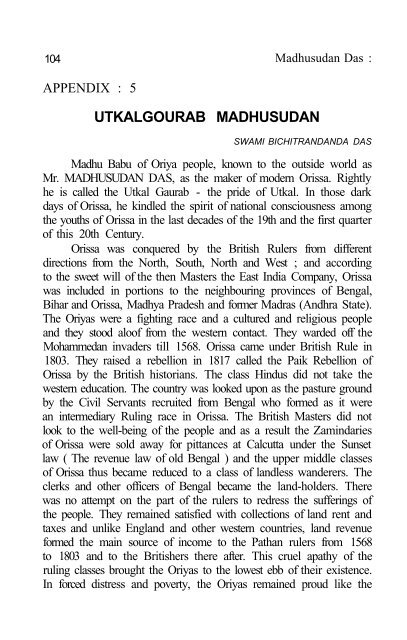Madhusudan_Das
Madhusudan_Das
Madhusudan_Das
You also want an ePaper? Increase the reach of your titles
YUMPU automatically turns print PDFs into web optimized ePapers that Google loves.
104 <strong>Madhusudan</strong> <strong>Das</strong> :<br />
APPENDIX : 5<br />
UTKALGOURAB MADHUSUDAN<br />
SWAMI BICHITRANDANDA DAS<br />
Madhu Babu of Oriya people, known to the outside world as<br />
Mr. MADHUSUDAN DAS, as the maker of modern Orissa. Rightly<br />
he is called the Utkal Gaurab - the pride of Utkal. In those dark<br />
days of Orissa, he kindled the spirit of national consciousness among<br />
the youths of Orissa in the last decades of the 19th and the first quarter<br />
of this 20th Century.<br />
Orissa was conquered by the British Rulers from different<br />
directions from the North, South, North and West ; and according<br />
to the sweet will of the then Masters the East India Company, Orissa<br />
was included in portions to the neighbouring provinces of Bengal,<br />
Bihar and Orissa, Madhya Pradesh and former Madras (Andhra State).<br />
The Oriyas were a fighting race and a cultured and religious people<br />
and they stood aloof from the western contact. They warded off the<br />
Mohammedan invaders till 1568. Orissa came under British Rule in<br />
1803. They raised a rebellion in 1817 called the Paik Rebellion of<br />
Orissa by the British historians. The class Hindus did not take the<br />
western education. The country was looked upon as the pasture ground<br />
by the Civil Servants recruited from Bengal who formed as it were<br />
an intermediary Ruling race in Orissa. The British Masters did not<br />
look to the well-being of the people and as a result the Zamindaries<br />
of Orissa were sold away for pittances at Calcutta under the Sunset<br />
law ( The revenue law of old Bengal ) and the upper middle classes<br />
of Orissa thus became reduced to a class of landless wanderers. The<br />
clerks and other officers of Bengal became the land-holders. There<br />
was no attempt on the part of the rulers to redress the sufferings of<br />
the people. They remained satisfied with collections of land rent and<br />
taxes and unlike England and other western countries, land revenue<br />
formed the main source of income to the Pathan rulers from 1568<br />
to 1803 and to the Britishers there after. This cruel apathy of the<br />
ruling classes brought the Oriyas to the lowest ebb of their existence.<br />
In forced distress and poverty, the Oriyas remained proud like the


